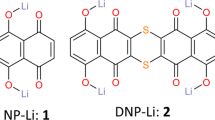Abstract
The use of redox active organic compounds as an alternative positive electrode material of rechargeable lithium batteries can be a solution for the resource issues of the current battery system. To satisfy both the high capacity and long cycle life of the batteries using organic active materials, naphthazarin (5,8-dihydroxy-1,4-naphthoquinone) derivatives, which potentially exhibit a four-electron transfer redox reaction, were investigated. While the unsubstituted naphthazarin lithium salt (1), having a high theoretical capacity of up to about 550 mAh g−1, showed only half the expected capacity and a short cycle life as a positive electrode active material, the chloro-substituted ones (1-Cl 2 , 1-Cl 4 ) exhibited improved properties in both their initial capacity utilization and cycle life. In addition, the high stability of a chloro-substituted naphthazarin salt (1-Cl 4 ) was supported by a reversible electrochromic behavior during the redox reaction. The substituent effect of the naphthazarin derivatives on the cycle stability was discussed with respect to the battery performance and electrochromic behavior. Also, a guide for designing a new organic active material which shows a high capacity and long cycle life is suggested.







Similar content being viewed by others
References
Novák P, Müller K, Santhanam SV, Hass O (1997) Electrochemically active polymers for rechargeable batteries. Chem Rev 97:207–281
Armand M, Tarascon JM (2008) Building better batteries. Nature 451:652–657
Nishide H, Oyaizu K (2008) Toward flexible batteries. Science 319:737–738
Nakahara K, Iwasa S, Satoh M, Morioka Y, Suguro M, Hasegawa E (2002) Rechargeable batteries with organic radical cathodes. Chem Phys Lett 359:351–354
Yoshikawa H, Kazama C, Awaga K, Satoh M, Wada J (2007) Rechargeable molecular cluster batteries. Chem Commun 30:3169–3170
Chen H, Armand M, Demailly G, Dolhem F, Poizot P, Tarascon JM (2008) From biomass to a renewable LixC6O6 organic electrode for sustainable Li-ion batteries. ChemSusChem 1:348–355
Inatomi Y, Hojo N, Yamamoto T, Watanabe S, Misaki Y (2012) Construction of rechargeable batteries using multifused tetrathiafulvalene systems as cathode materials. ChemPlusChem 77:973–976
Matsunaga T, Kubota T, Sugimoto T, Satoh M (2011) High-performance lithium secondary batteries using cathode active materials of triquinoxalinylenes exhibiting six electron migration. Chem Lett 40:750–752
Morita Y, Nishida S, Murata T, Moriguchi M, Ueda A, Satoh M, Arifuku K, Sato K, Takui T (2011) Organic tailored batteries materials using stable open-shell molecules with degenerate frontier orbitals. Nat Mater 10:947–951
Yokoji T, Matsubara H, Satoh M (2014) Rechargeable organic lithium-ion batteries using electron-deficient benzoquinones as positive-electrode materials with high discharge voltages. J Mater Chem A 2:19347–19354
Yokoji T, Kameyama Y, Sakaida S, Maruyama N, Satoh M, Matsubara H (2015) Steric effects on the cyclability of benzoquinone-type organic cathode active materials for rechargeable batteries. Chem Lett 44:1726–1728
Yokoji T, Kameyama Y, Maruyama N, Matsubara H (2016) High-capacity organic cathode active materials of 2,2′-bis-p-benzoquinone derivatives for rechargeable batteries. J Mater Chem A 4:5457–5466
Yao M, Senoh H, Yamazaki S, Siroma Z, Sakai T, Yasuda K (2010) High-capacity organic positive-electrode material based on a benzoquinone derivative for use in rechargeable lithium batteries. J Power Sources 195:8336–8340
Yao M, Yamazaki S, Senoh H, Sakai T, Kiyobayashi T (2012) Crystalline polycyclic quinone derivatives as organic positive-electrode materials for use in rechargeable lithium batteries. Mater Sci Eng B 177:483–487
Yao M, Ando H, Kiyobayashi T (2013) Dialkoxybenzoquinone-type active materials for rechargeable lithium batteries: the effect of the alkoxy group length on the cycle-stability. Energy Proc 34:880–887
Yao M, Numoto T, Araki M, Ando H, Takeshita HT, Kiyobayashi T (2014) Long cycle-life organic electrode material based on an ionic naphthoquinone derivative for rechargeable batteries. Energy Proc 56:228–236
Yao M, Numoto T, Ando H, Kondo R, Takeshita HT, Kiyobayashi T (2016) Improving the cycle-life of naphthoquinone-based active materials by their polymerization for rechargeable organic batteries. Energy Proc 89:213–221
Ambrose JF, Carpenter LL, Nelson RF (1975) Electrochemical and spectroscopic properties of cation radicals III. Reaction pathways of carbazolium radical ions. J Electrochem Soc 122:876–894
Yoshino S, Hayakawa K, Kanematsu K (1981) Reagent design and study of p-benzoquinone derivatives. Site-selective cycloaddition reaction of diquinones and photochemical cage formation of the adducts. J Org Chem 46:3841–3846
Pochorovski I, Boudon C, Gisselbrecht JP, Ebert MO, Schweizer WB, Diederich F (2012) Quinone-based, redox-active resorcin [4] arene cavitands. Angew Chem 51:262–266
Novikov VL, Balaneva NN, Shestak OP, Anufriev VP, Glazunov VP (2016) Cycloacylation of chloro-substituted hydroquinone dimethyl ethers with dichloromaleic anhydride. Russ Chem Bull Int Ed 65:993–1003
Huot R, Brassard P (1974) Friedel-Crafts condensations with maleic anhydrides. III. The synthesis of polyhydroxylated naphthoquinones. Can J Chem 52:838–842
Bruce DB, Thomson RH (1955) Quinones. Part V. The chemistry of naphthazarin. J Chem Soc 5:1089–1096
Shimizu A, Kuramoto H, Tsujii Y, Nokami T, Inatomi Y, Hojo N, Suzuki H, Yoshida J (2014) Introduction of two lithiooxycarbonyl groups enhances cyclability of lithium batteries with organic cathode materials. J Power Sources 260:211–217
Acknowledgements
We thank Ms. Miho Araki, AIST, for her technical support.
Author information
Authors and Affiliations
Corresponding author
Ethics declarations
Conflict of interest
The authors declare that they have no conflict of interest.
Rights and permissions
About this article
Cite this article
Yao, M., Umetani, S., Ando, H. et al. Rechargeable organic batteries using chloro-substituted naphthazarin derivatives as positive electrode materials. J Mater Sci 52, 12401–12408 (2017). https://doi.org/10.1007/s10853-017-1368-z
Received:
Accepted:
Published:
Issue Date:
DOI: https://doi.org/10.1007/s10853-017-1368-z




